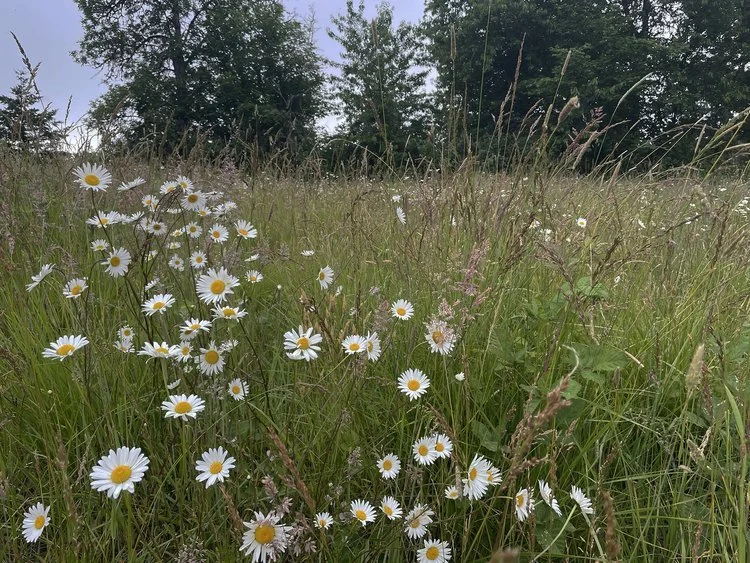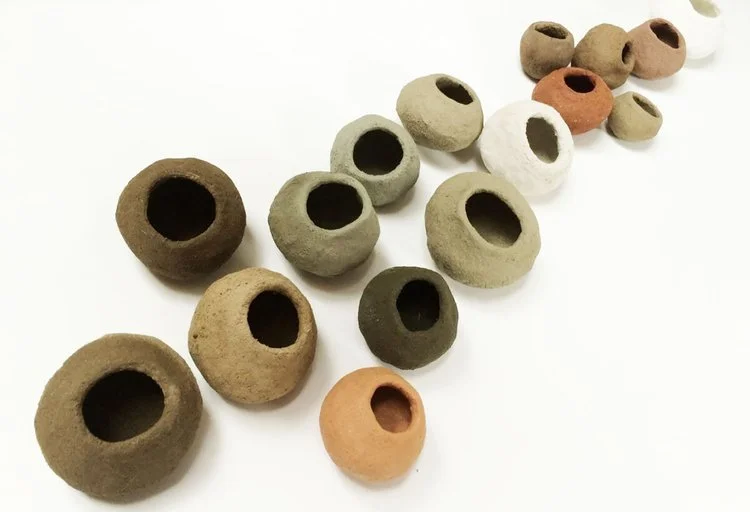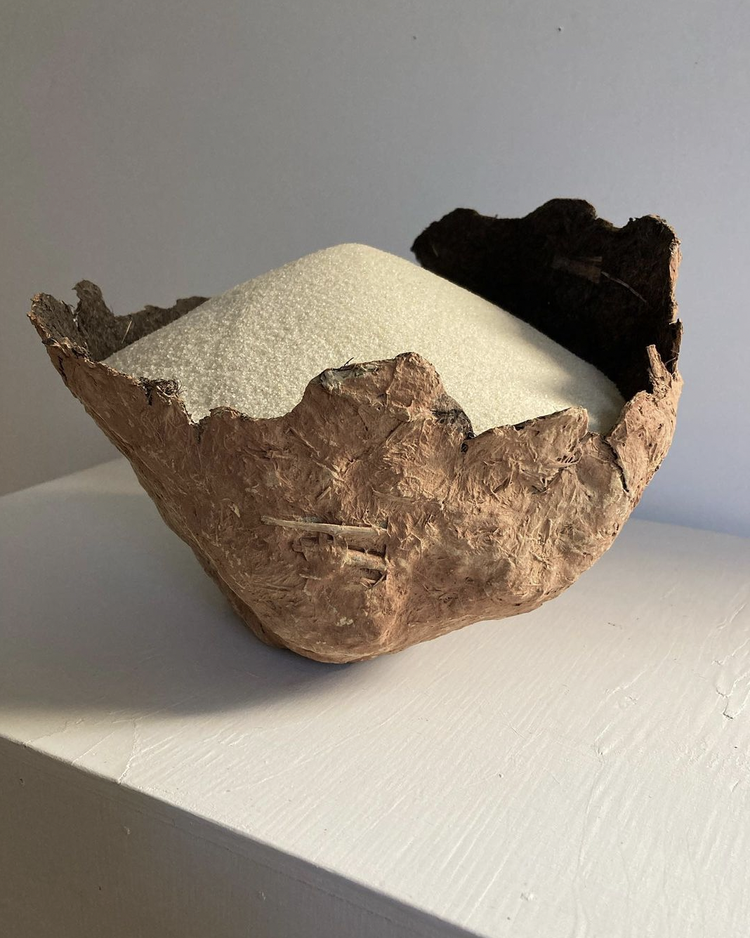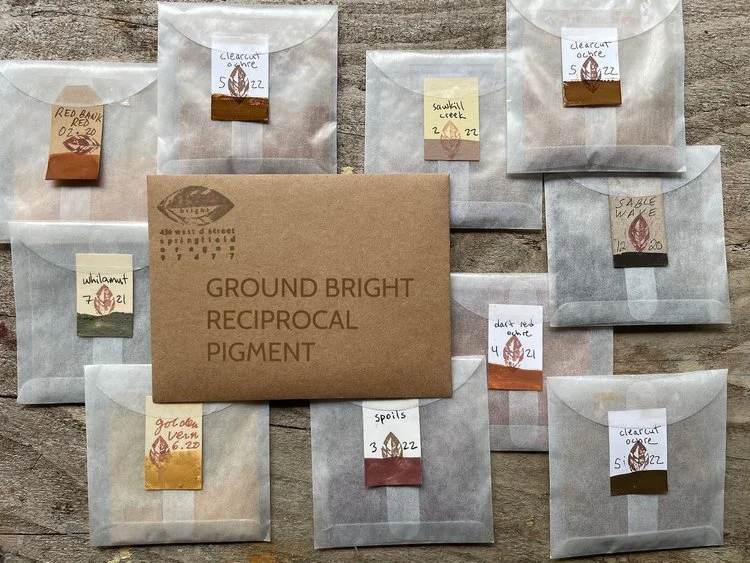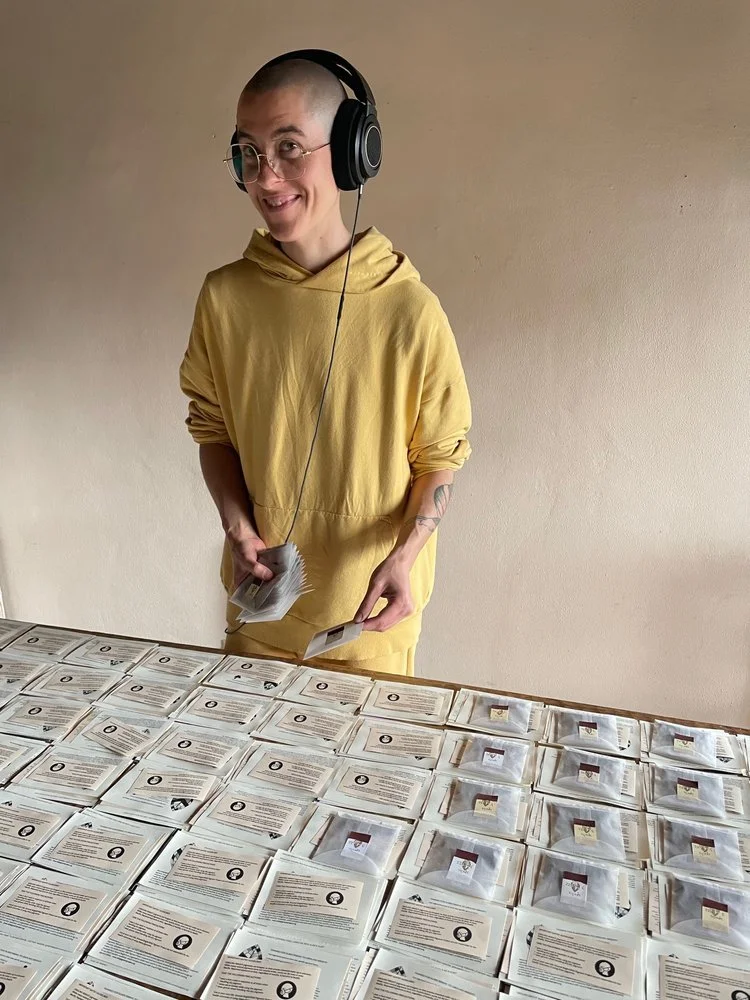pied midden: issue no. 32 : prints in the clay : teri power
Clay pigments, including Hillside Slough, on bottom. Photo by Tilke Elkins.
paths in the grass
I find my family in the distant bird calls at dawn, the soft roiling of crows cawing to each other from the treetops. Dawn air seeps in through the window and fills the room with its bright potency. June is the fullest month, green potential stacked to the tipping point, ready to pour itself into fruit but not, quite, yet, holding the accumulation of winter’s gathering and spring’s growth as ecstatic green towering life, waiting to spill into seed, to condense again, to dry in summer’s late heat and tighten and store and sleep, but not, quite, yet.
I feel my heart riding on the molecules of this June florescence. This expansive inhale at the top of the cycle of life is a resting, a wafting, a billow of tossed canopies and waves rippling over defiantly long grass. The grass heads shake out clouds of pollen as my hand hits them, my palm registering an innumerable cast of seed head textures: tight purple sausages, feathered tufts, stiff pods held in suspension from each other like steel mobiles, small bunches of round seeds quivering on their stalks like paused fireworks, and the plaited tails fluffy like fox wheat. This season of grass catches me awake.
This air holds me like family. It’s layered thick with memories of being, mine and so many others, and this all swims through me as I breathe in the moisture, the coolness, the promised warmth to come. Tiny sounds and smells pivot me between centuries, the feeling of an afternoon two hundred years ago, or when I was six, or yesterday. Swimming through time like this holds me to a knowing of life beyond the friction of human paradoxes in 2022.
Time of grasses. Photo by Tilke Elkins.
longing for that deep time connection
The tragedies that the culture I live in has tried to bury, and the devastation of biodiversity that rises up all around us, and the looming of possible world annihilation in an instant: these things aren’t just problems to be solved. They’re experiences to live in, with. In being with whatever may come, I want affinities with others who right now feel the family in the air, who speak, and hear, and respond to languages not devised by humans. Who believe not just that ‘the world is alive,’ but that the world is speaking, and listening. I’ve had the honor and joy to know handfuls of people who hear these other languages, friends scattered through this culture I’m in that shames children and whoever they become for thinking that anyone but human people can talk to us. And, I’ve felt relieved and comforted by the presence of cultures not my own that assume all life forms are family.
I know that this continent was a place of unimaginable beauty when my earliest North American ancestors arrived here in 1632 on the Jubilee, not only because I have a tendency to romanticize the past and First Nations histories in general, but because I’ve read the first-hand accounts of what the ecosystems here looked like before they were reduced to the fragmented state they’re in today. The East Coast had millions of acres of old growth chestnut forest (the edible kind) with understories so open you could canter a horse through them. (They were finished off by blight arriving on imported wood in the 1800s.) The Plains, of course, were covered in tall prairie grasses in an ecosystem kept in balance by the vast numbers of buffalo who were at the center of the human life cycle (and were slaughtered by the millions by settlers to starve out the Crow, Cree, Arapaho, Ute and Lakota people.) And the valleys of much of the West Coast were a series of oak savannas — places of some of the richest biodiversity on the planet — where the growth of firs and other trees was limited by the cultural practice of controlled burning, and acorns provided a reliable food base. Large Indigenous communities thrived in permanent settlements from East to West.
It was no accident that these ecosystems were so favorable to humans. They were developed over thousands of years by the people who thrived in them. These days, this ancient wisdom has a snappy acronym, TEK, or Traditional Ecological Knowledge. Have you heard of it? If not, you will. All over the planet, communities that have lived in sustainable relationship with land for millennia are attempting to rebuild from centuries of genocide and cultural erasure. They’re forging support systems — with the help of the internet and social media — and raising funds, buying back ancestral lands, and establishing centers of traditional knowledge. European Americans like me, who want Indigenous communities to thrive, for many different reasons (a sense of kinship with other-than-humans among them) — support these efforts. Personally speaking, the desire to do so is not just a romanticization of another culture, or a need to assuage my guilt about ancestral crimes. I do romanticize sometimes (I’m incurably romantic in quite a few things), and yes, I do have — not guilt, exactly, but huge sorrow about the trajectory my ancestors were caught up in, and a desire to be different, to act towards balancing the evil that was and continues to be done. So, it’s those things. And, this — that most (all?) Indigenous cultures uphold what I consider the barest requirement of being human: a respectful regard for other beings as equals. But is it something more?
Artist Cannupa Hanska Luger: Photo from the New York Times, June 7th, 2022, by Cara Romero.
Cannupa Hanska Luger thinks so. He’s an artist who uses sass and ferocity to confront colonizer culture. You may remember the mirrored shields he instructed water protectors at Standing Rock to make to reflect the absurdly inured faces of the cops in full riot gear as they advanced towards the peaceful protestors. These days, he’s still confronting colonial powers. When recently invited to make a monument for the Yale campus, he suggested a machine that stamps ordinary coins to read ‘I ACKNOWLEDGED INDIGENOUS LAND TODAY,’ coins to be later attached together to form chain mail used to cover a piece of land on campus that will then be formally deeded back to the descendants of the Indigenous peoples the land was stolen from. Another of Luger’s proposals involves building a massive monument to the millions of bison murdered by white settlers and inviting the descendants of the Texan family who amassed a fortune in the barbed-wire fencing boom that followed the slaughter to pay for the monument.
In an article by Tlingit reporter Joshua Hunt for the New York Times, published last week, Hunt recounts Luger’s comments on his empathy for colonizers. Hunt asks if it’s “anger or mischief that motivat[es] [Luger] to provoke white institutions.” Luger says it’s neither. “I don’t see them as provocations,” he explains. “I see them as opportunities. I’m giving them a gift. I’m giving them the opportunity to make themselves whole again.”
I suspect Mr. Luger is speaking with at least a little tongue in his cheek. If there is a path back to wholeness for the crimes against the planet set in motion by my ancestors, it’s one that will take more than a generation to follow. Luger sees the process of Becoming American, for colonizers, as a trauma resulting from the severing of all ties to our ancestral lands. This trauma, he says, has left us with a longing for what he calls a “deep time connection,” to the land we now inhabit, which we don’t have, of course, because we’re on someone else’s ancestral land. I resonate with this. It’s a profound, multigenerational loneliness. And — it’s true. We can never belong to land, that way. And no amount of support for Indigenous communities can bring us that.
Why do I volunteer my time and contribute financially to the Indigenous community where I live? It’s fun, and I like the people I’ve connected with because of it. I do it out of respect for this place, here in this valley on Kalapuya ancestral lands, because even though I wasn’t welcomed here, I am a guest. I do it to honor the Kalapuya ancestors who tend the beings I feel kinship with. I do it because it’s my understanding of a reciprocal cycle I can identify and participate in, where I take from the land and give back to the people who belong to the land as I never will. And the small acts of reciprocity that pigment foraging affords me are the closest I can get to a real familial relationship with land, a give-and-take. Will this make me whole or fix the past? No. That’s a deep-time process in its early stages. But does it help me feel more whole than fragmented? Yes.
Kalapuya elder Esther Stutzman and her descendants are in the midst of an exciting new land rematriation, by the way, that they’re calling the Cha Tumenma Land Project. It’s happening on over 200 acres of their traditional territory, where they plan to create a community garden, build a permanent space for the Native youth summer camps they’ve been holding for decades, and practice cultural burnings and sustainable forestry. Esther Stutzman helped create and recently published the first Kalapuyan dictionary, and the primary intent of the land project is to “involve native youth in awareness of their culture and traditions using research, cultural knowledge and related activities.” You can support Cha Tumenma, here. With support from Kalapuya elders, I’ve gathered pigments for Ground Bright that have resulted in several monthly contributions to Kalapuya summer culture camps, and plan to direct funds to Cha Tumenma later this year.
Photo from the Cha Tumenma GoFundMe page.
Wild Pigment Project is one direction that my attempts to find a path to wholeness has taken. I still don’t know if participating in the disturbance of five and a half pounds of earth each month (that’s about how much is required to fill the Ground Bright subscriptions), and the shipping of it off to the far corners of the planet is the right thing to do. Some days I very much think it isn’t.
Handfuls of earth taken from unceded lands by a Euro-American like me can look very much like a reenactment of the stealing of land enacted by our ancestors. That’s been clear to me from the start. And —the handfuls I take also mirror the taking from/of land enacted every time I exchange money for food, clothes, electronics, or anything at all: all this comes from land, is land. Foraged pigment presents an ethical object lesson of microcosmic proportions. It’s a context where choice can be applied to an exchange that parallels the thousand tiny acts of exchange performed regularly that don’t seem open to choice, even if they are. To call attention to the wrongness inherent in my taking ochres from their places and sending them away is to open a meeting space for the discussion of exactly why it — and so many other things I do, as a Euro-American and modern person — may be wrong. The willingness to stand in wrongness for the sake of a conversation that feels so needed to me is a reciprocal offering I make through Wild Pigment Project.
What does it mean for me to share earths through this project? What does it mean for artists who are not of settler colonizer descent to contribute to Ground Bright, or to subscribe? The meanings are different, for Indigenous North American artists, for Black artists, for Black Indigenous artists, and for First Nations artists from other parts of the world, as they are for people with other lineages not mentioned here. The conversations that come up are interwoven. Everyone has their own path to wholeness, and everyone is on a different stretch of that path. Wild Pigment Project hopes to offer a point of intersection.
Poetry of Place, by Teri Power; clay, eight 7″ diameter pinch plates, 2017. Image courtesy of Teri Power.
now back to the dirt
This month’s Ground Bright contributor is European American artist Teri Power, who lives near the St. Croix River Bluff by Hudson, Wisconsin, on the traditional lands of the Wahpehkute Dakota people. Power is a retired schoolteacher who delighted in helping children get their hands dirty, explore, and create. Now, her studio practice incorporates a range of materials, from painting and paper-making to ceramics. She foraged for her pigment contribution, called ‘Hillside Slough,’ on the edge of an eroding hillside that was cut to make room for a restaurant parking lot. Teri first came across clays as potential pigment through an artists’ group that encouraged her to ‘get to know a specific place.’ Motivated by talk of ‘sustainability,’ Teri wondered if she could make all her work using what she found in the place she chose. Her exploration of place and local clay has brought her to examine issues related to water, and, more recently, to make work that highlights the impact that the extraction of sand for fracking has on the landscape where she lives.
interview with teri power
WPP: Teri, you're a pigment artist who works pretty much exclusively with clay pigments -- as opposed to soil or rocks. Before we go farther, would you mind explaining to readers how you tell the difference between clay and other forms of minerals?
TP: Yes, I use almost entirely clays in my work — it’s what distinguishes me from other artists who work with mineral pigments. I love working with clay pigments for a couple of reasons. I like the constraint of using only what I can forage sustainably (which in my case is mostly clay!) and, I think it’s a material that hasn’t been investigated as much by artists as other mineral pigments, like earths or rocks. I’m amazed by the variety of colored clays I’ve found, and each source is unique.
I also appreciate clay’s role in the origin of life on the planet. Scientists exploring the beginning of life attribute a life-friendly environment to the presence of clay minerals! Some clays, like bentonite, are formed from volcanic activity. So, what exactly IS clay? It’s basically an an eroded form of rock — a fine grain soil. I’m self-taught and have tried to learn about the science of clay. I’ve tried to define clay for about 12 years now and experts tell me its too hard to explain! It’s a slippery subject as well as a slippery material.
WPP: Haha, I know what you mean! From what I can tell, there seem to be two separate definitions. Some say that any minerals with particles smaller that 2 microns can be considered “clay” but then they go on to say that there are quite specifically clay minerals that have distinct properties, namely a structure of platelets that allows the particles to absorb enormous amounts of water and expand to be up to a hundred times their dried-out size. Lots to study, here! As I’m sure the ceramicists reading this will agree.
Are there places where clay tends to accumulate? Do you usually just happen upon a good clay patch, or do you seek it out by identifying places where you think it’s likely to be found?
TP: Although clay is present in certain soils, I look for deposits that are mostly clay. Clay can be deposited in places with slow-moving water, like on creek beds, and also in lakes, which is known as ‘lacustrine deposition,’ which becomes visible in places where the shoreline has receded. It can be seen in layers of soil where there has been a cutaway. Clay can either be found at the source of its formation, or in a place where it has moved to, through run-off or erosion after forming These are called primary and secondary sources. I explore mostly in the midwest and here you find wet clay easily but in other parts of this country it’s more commonly found in a dried form. You can test it with some water if you are not sure it is clay, to see if it can be easily shaped into a ball once it’s wet. You would be amazed…it seems to be everywhere.
Concerning Source, detail, pinch pots, 2016. Image courtesy of Teri Power.
WPP: Oh, yeah, it’s much more common than I used to think. I’ve learned that crackled dried mud surfaces that show a lot of deep, wide cracks are good indications of the presence of clay, as are tire or animal tracks in dirt roads that hold their precise markings well. Sand and dirt don’t shrink when they dry, or hold prints with much accuracy, but clay does.
Teri, can you walk me through the steps you take to get your foraged clay ready to be used as a pigment?
TP: Wild clay often has a fair bit of organic material in it — decomposing leaves, roots, bark and so on. Cleaning and sifting clay is necessary to prepare it for use as a drawing tool, which is one of my favorite ways to work with clay pigments. The cleaning and sifting process is even more important than adding binders, when it comes to making a good clay pastel. Some clays are so fine that you can get away with not adding a binder to them at all, but if you don’t filter out the organic material, they’ll fall apart regardless of how good your binder is. That’s the main piece of advice I have for artists wanting to make clay pastels!
So, my process. I bring home a clay-like material. I know clay by its stickiness, smoothness, and general texture which indicates a fine particle size. It holds together well and retains formed shapes. I place the wet clay in water at a ratio of 5:1, water to clay. After making an even slurry, I begin to pour the clay “slip” out into a sieve lined with cheesecloth. This initial rinse removes sticks, stones and other debris. What’s left is a fine, filtered clay-water mixture. I leave it in the container I’ve poured it into and let it sit for a day, until a layer of clear water sits atop the settled clay.
Next, I siphon or pour the water off and let the clay sit and resettle. Usually the clay is still too wet to form into balls at this point, so I let the water evaporate a little until the clay has a moisture level I’m happy with. If you get impatient you can pour an almost ready watery clay or ‘slip’ onto a plaster bat [a form used to remove pottery from a wheel] and it will quickly absorb any moisture you wish to remove. When it’s the desired consistency, I bag it, mark it and log it in my records. I also take photos at the source to keep with my records. Now the bagged clay is ready to use.
Overreach, by Teri Power; cattails, clay, fracking sand; 2022. Image courtesy of Teri Power.
WPP: Can you tell us about your recent piece, Overreach? What inspired you to make this piece and what sort of "foraging" did it require?
TP: The piece was created for a poetry/art collaboration for a small gallery in Minnesota. We selected a poem and then responded to it…The poem was about “lust”…but a lust for found blueberries! I guess I got a bit serious with my response…..So I foraged the clay and cattail fibers as well as made the black walnut ink from a local tree. This frac sand issue is big in Wisconsin and there are two refineries near me. Sand falls off trucks and train cars as they transport the sand to use for mining natural gas out East. The dust from the silica sand is dangerous to breathe, because of its fine particles, which can clog the lungs and cause lung damage and cancer, so I’m careful when I gather it. The “mining” of the frac sand is being done on farmlands where owners sell out to the refineries because it is so lucrative for them but essentially the landscape is forever altered and damaged and no longer good for tilling. I worry about all this stuff. I’ve done a lot of work about this issue but not all with natural materials — some with other types of work. There are some on my website.
The piece is called OVERREACH, as in ‘reaching too far… taking too much.’ Frac sand…oil…gas…are we entitled? My communities take from the earth with disregard to the outcomes and health of the earth and its inhabitants, changing landscapes. We need and do not give back. This creed has created the imbalance in the earth that some of us are desperately trying to rectify. Or at the very least abate.
WPP: You've chosen to direct the 22% Ground Bright donation to the Indigenous Peoples Task Force this month. Would you like to say a little bit about how you learned about this group and why you want to support them?
TP: I’ve been aware of the Nibi Walks — also called ‘Water Walks’ — for many years now. Nibi Walks are Indigenous-led, extended ceremonies to pray for the water. A few years ago, I was involved in a show I co-curated called ‘Concerning Water.’ It was an extension of a show called ‘Women and Water’ originally shown at the University of Minnesota. There was a wall of honored women who have been influential in water issues. I nominated Josephine Mandamin to be added to the honor wall. As an Ojibwa grandmother she was the original leader of the Nibi Walks. Sharon Day has also been quite involved in Nibi Walks, and so over the years I’ve become aware of her role as a community leader. These days, she’s doing great community work in Minnesota with the Indigenous Peoples Task Force, where they’re planning an improved community center in Minneapolis. I was born and raised in Minnesota and we live about an hour from Minneapolis in Wisconsin. Our three daughters live in St Paul. So Minneapolis is a focal point for me in many respects. I want to support the work of Sharon Day and the Indigenous Peoples Task Force for their success in providing local education about HIV/AIDS prevention, building and supporting community, upholding Indigenous values and especially for their work with the youth.
WPP: Thanks so much, Teri, for this interview and for your pigment contribution to Ground Bright — the gorgeous olive clay we’ve called ‘Hillside Slough.’ And thanks for making this donation to the Indigenous Peoples Task Force possible.
(end interview)
reciprocal pigment & other dust
As an artist who, until founding Wild Pigment Project in 2019, was almost never able to donate cash money to anyone, I continue to feel jubilant when I make the Ground Bright 22% donation each month. Still, I’ve wanted a way to offer the pigments to artists who don’t want to exchange money for pigment, without just calling them “FREE PIGMENTS!” which evokes something you get at the bottom of a box of Froot Loops.
Artist Marjorie Morgan and I talked this winter about the language of giving. At her advice, I’d started in on reading and responding to the guided deep-dive into anti-racism that is Layla Saad’s excellent book, ‘me and white supremacy.’ Since spending time with the chapter on white saviorism, I’ve been thinking about how scholarships and other forms of giving can maintain white supremacist hierarchies. What I’m interested in with WPP is supporting access for all, and acting in reciprocity with people and groups who want what WPP has to offer. My thinking around this evolved into the Ground Bright Reciprocal Pigment program. Every month, pigment from the GB archive is offered for zero dollars to whoever signs up for it before the supply runs out. In exchange, each person participating is asked to (optionally) answer The Cycle of Reciprocity Question:
How does the offered Ground Bright pigment fit into a reciprocal cycle for you?
In other words, how might the gift of this pigment be an offering to you for the ways you show up in the world to support others? Or, how is this pigment a return of energy you or your ancestors have contributed in the past? Alternatively, how do you plan to share this pigment, or what you learn from the pigment, with the world? What gifts can you give through this pigment?
The pigments went fast this time, so fortunately will be offered every month, on the 12th or so. Here are some of my favorite responses, submitted anonymously:
‘I am currently beginning with regenerative farming a dyers garden that is meant to be reciprocal, too. This pigment would be used as a spiritual starter.’
‘I am gifting it to my nine year old, who makes clay pigments here but never touched a processed one or has gotten to experience pigment from far away. She wants to make drawings with it, as gifts. But honestly you inspire her a lot and we can't afford to join you.’
‘Life itself is reciprocal isn’t it? The gift of this ground pigment will find its way into another gift. I’m not sure who the gift will be for because as an artist, and a gift giver, these kinds of knowings happen in the moment, in the process…’
Clicking open each of these responses is just like unwrapping a present, let me tell you. Thank you, thank you to all those of you who joined this cycle!
Many thanks, also, to my partner Noelle Guetti, who is now officially the Ground Bright staff of one. She puts the packets together each month from start to finish, and has been doing so for more than a year, as a sort of pleasant, rhythmic interlude from her extremely dynamic practice as a textile artist. When she’s not using math to make nettle and clay-dyed hemp or linen dance in glorious patterns of cloth, she’s designing clothes to fit actual human bodies (not idealized ones), researching unusual loom technologies, or devising studio uniforms for artists (more on this to come!). Wild Pigment Project would be a pale shadow of its current self, were it not for her generous input and exuberance. Limitless thanks for all the ways you shine your love on me AND this project, Noelle… <3<3<3
And thanks for your attention, dear reader, if you’ve managed to read this far! Do write and let me know your thoughts, if you’re moved to. They’re presents in my inbox. Find me at info@wildpigmentproject.org or just hit “reply” to this newsletter.
Stay Malleable,
<3 Tilke
Noelle Guetti gets ‘Wandering Winterkill’ ready for the journey out to subscribers. Photo by Tilke Elkins.


